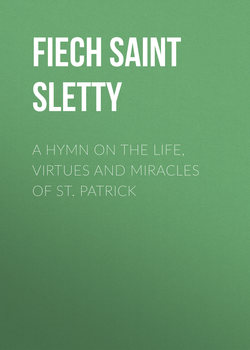Читать книгу A Hymn on the Life, Virtues and Miracles of St. Patrick - Fiech Saint Bishop of Sletty - Страница 2
INNUIN PATRAIC
ОглавлениеI
Genair Patraic i nem Thur,1
Asseadh ad fét hi scëlaibh,
Macan sé m-bliadharn decc
An tan do bhreth fo dheraibh.
II
Succat a ainm hitrubhradh
Cidh a atair ba fisse,
Mac calpuirn mic Otide
Ho Deocain Odisse.2
III
Baisë bliadhna bi foghnamh
Maise doine nïs tomledh
Bitar le cothraighe,3
Ceathar trebha dia fognadh.
IV
As bert Uictor fri gniadh
Milcon, teseadh far tonna
Forruibh a chois for sind leic
Maraidh dia aes ni bronna.
V
Do faidh tar ealpa uile4
De mhuir, bo hamhra reatha
Comdh fargaibh la Gearman
Andeas an deiscort leatha.
VI
An-innsibh mara toirrian
Ainis indibh, ad rimhe,
Lëghais cannóin la Gearman
Is eadh ad fiadhad line.
VII
Do cum n-Erenn dod fetis
Aingil de hi fithis,
Menic it chithe ifisibh
Dos mcfed arithisi.
VIII
Ro po cobhair don D-Eren
Tichta Patraic for Oclat:
Ro clos cian son an garma
Macraidhi caille fochlad.
IX
Gadhadair co tisseadh in noebh
Ar a nimthised lethu,
Ar atin taradh o cloean
Tuath a h-Eren do bheathu.
X
Tuata h-Eren Tairchantais
Dos nicfead Sithlaith nua,
Meraidh co ti amartaige
Bidh fás tír temhrach.
XI
A Dhruidh ar Laoghaire
Tichta Patraic ni cheiltis,
1
In the Latin translation accompanying Colgan's edition of this Hymn Nein Thur, or Holy Tours, is rendered into Nemthur, as if the two words were but one, designating a place of that name. In the fifth and ninth stanzas, the word Lethu or Letha, is rendered by Latium or Italy: upon which absurd translation, Colgan, without rectifying the mistake, observes that Nisi Germanus dicatur degisse in eis (insulis Tyrrheni maris) videtur hic preposterus ordo; "except St. German be said here to have lived in them, (the islands of the Tyrrhenian sea,) the order of time seems preposterous." So contradictory does this appear to the Latin translator, that he has totally mistranslated the 17th and 18th verses, in which Letha again occurs, by his omitting the word altogether. The editor's reason for deviating from the Latin translation may be seen, at full length, in the preceding work.
2
Colgan, from the psalter of Cashel, traces back St. Patrick's pedigree to the 17th progenitor, thus:
From the names of the above list, if they could be depended on, it would appear that St. Patrick's ancestors were of Roman origin.
3
As Father Michael Clery, one of the annalists called the four masters was employed for fifteen years previously to the Anglo-Cromwellian invasion in collecting Irish manuscripts, and translating them into Latin for Colgan's Lives of the Irish Saints, it is very probable he was the translator of this Hymn into Latin at the same time. He was also the author of an Irish dictionary of difficult words. To the translation of such a scholar, made also at a time when the language was regularly studied in the seminaries of Ireland, great deference must be paid. In this third stanza, however, the editor has ventured to deviate from his version, which runs thus, according to the Latin words "St. Patrick was six years in slavery, during which he eat not the food of the (heathenish) people. For this reason he was called Cathraige, because he served four masters." Now, as Cothraighe may also mean a supporter, maintainer, protector, &c. this last import of the word is adopted in the English translation.
4
Instead of St. Patrick's running over the Italian "Alps," as the Latin translator affirms here, he travelled over all the mountains from the north to the south of Ireland, whence he took shipping for his native country; for Ealpa uile denotes all mountains in general.
